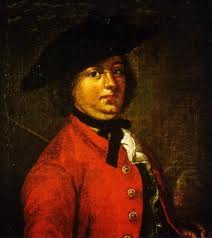One of the most well-known cross dressers who went to sea was Hannah Snell, born in 1723, to a hosier/dyer and his wife on Fryer Street in Worcester, England. Her grandfather was Captain-Lieutenant Snell who took part in the conquest of Dunkirk and the battle of Blenheim, a turning point in the War of the Spanish Succession.
Hannah was one of nine children. Except for one of her sisters, all nine grew up to become soldiers, sailors, or the wives of such. Hannah reports playing army as a girl; no surprise, having six brothers. She formed a company of young soldiers among her playfellows, of which she was chief. “Young Amazon Snell’s Company” would parade through the town of Worcester.
After the death of her parents, Hannah went to London to live with her sister and brother-in-law James Gray, a carpenter in Wapping. At twenty-one she married a Dutch sailor, James Summs, who abandoned her when she was seven months pregnant. The baby didn’t live long and Hannah set out to find him, taking her brother in law’s name, and a suit of his clothes. She claims to have enlisted in the army but soon deserted, then traveled south to Portsmouth and enlisting in the marines, where she served aboard the sloop-of-war Swallow. The Swallow was sent to India with Admiral Boscawen’s fleet and Snell was sent ashore to fight the French in Pondicherry. She was wounded numerous times. One wound was to the groin. She removed the ball and dressed it herself, with the help of an Indian nurse, so her sex would not to be discovered. As soon as her health was restored she was sent on board the Tartar Pink to perform the duties of a common sailor, then was assigned to the Eltham man-of-war which set sail for Bombay.
Hannah Snell lived and worked as a man for more than four years. When at last she returned to her sister and brother-in-law’s home in London, she quit her disguise — then capitalized on her bold experiences by selling her story to the publisher, Robert Walker, who wrote and printed it. (Like many women of her time, Hannah could read but she couldn’t write proficiently.) Hannah also went on tour, re-enacting military drills before a thrilled audience, achieving significant fame. Hannah then applied for – and was granted –a pension for her war injuries.
Discovering that her estranged husband, James Summs, had been executed for murder, Hannah was free to marry again. She did so, outlived that husband, then married a third time and gave birth to a son. She lived on her pension, and on the money she made as a street peddler, to the age of 86 when she was committed to Bedlam hospital with “the most deplorable infirmity” (which might have been dementia and seizures secondary to neurosyphilis or meningovascular syphilis –forms of tertiary syphilis that present 4-25 years after infection). If this was the most deplorable infirmity the former marine suffered from, she might have contracted it from her first husband.
Hannah died in Bedlam in 1792.
The Female Soldier or The Surprising Life and Adventures of Hannah Snell was written, printed and sold by R. Walker, of London, in 1750. Some of the incidents he might have exaggerated, confabulated or otherwise made up, but by and large, her story is believable. Tales of women soldiers and sailors, disguised as men, were popular among Britain’s lower classes, who bought them in on the street in the form of inexpensive broadsheets and ballads. The publication of Hannah Snell’s story gave wider recognition among the middle and upper classes; people who could afford to buy books.
The protagonists of the many stories and ballads of cross dressing women were said to be in search of boyfriends or husbands who had run off to war, or pressed into the navy. This became a formulaic story, guaranteed to sell broadsheets and ballads. This motivation was likely interjected by male writers who could imagine no other reason a young woman might want to join the army or the navy.
And why would they, you ask? For the same reasons a young man might: The paycheck, the billet, the food, the camaraderie, the adventure, the chance to be part of a greater cause, the opportunity for travel — and the possibility of meeting a man (or in some cases a woman) worthy of your love? Most people lived hand to mouth, and struggled to get by. If you didn’t have money, a title, or a good man to support you, life was very hard for an 18th century woman. Who wouldn’t sell a petticoat and go to sea?
All ye noble British spirits
That midst dangers glory sought,
Let it lessen not your merit,
That a woman bravely fought…
Resources:
The Lady Tars: The Autobiographies of Hannah Snell, Mary Lacy and Mary Anne Talbot, with a Forward by Tom Grundner. Fireship Press, 2008. Tom Grunder encouraged my writing about the crossdressing Patricia MacPherson, and gave me this book to help me with my research.
For more salty history, visit my fellow shipmates blogging about all things nautical:
J.M. Aucoin http://jmaucoin.com/2013/09/
Helen Hollick http://ofhistoryandkings.
Doug Boren http://doug1401ck.blogspot.co.
Margaret Muir www.margaretmuirauthor.
Julian Stockwin http://julianstockwin.com/
Anna Belfrage http://annabelfrage.wordpress.
Andy Millen http://wp.me/p3GFor-1W
V.E. Ulett http://www.veulett.com/2013/
T.S. Rhodes http://thepirateempire.
Mark Patton http://mark-patton.blogspot.
Katherine Bone http://www.katherinebone.com/
Alaric Bond http://blog.alaricbond.com/
Ginger Myrick http://gingermyrick.com/
Judith Starkston http://www.judithstarkston.
Seymour Hamilton http://seymourhamilton.com/?p=
Rick Spilman http://www.oldsaltblog.com/
James L. Nelson http://jameslnelson.blogspot.
S.J. Turney http://sjat.wordpress.com/
Prue Batten http://pruebatten.wordpress.
Antoine Vanner http://dawlishchronicles.
Joan Druett http://www.joan-druett.
Edward James http://busywords.wordpress.
Nighthawk Newshttp://nthn.firetrench.com/

![2013-Nautical-Blog-Hop-small[1]](http://www.lindacollison.com/wp-content/uploads/2013/09/2013-Nautical-Blog-Hop-small11.jpg)